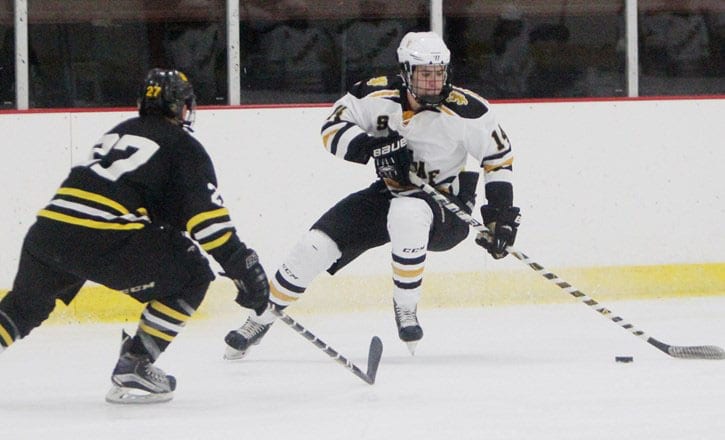
Heading into his second year with St. Olaf, the focus for men’s hockey head coach Mike Eaves is simple: develop a more balanced offensive attack that can consistently produce wins. During the 2016-17 season, the Oles were tied for seventh in the MIAC with 61 total team goals while averaging only 2.44 goals per contest, second to last in the conference. The good news is nearly a quarter of all those scores came from returning all-MIAC breakout star Drew Otto ’19, whose 15 goals and 28 points were tied for the third and fourth highest totals in the conference, respectively. Unfortunately, the next most prominent scorers on last season’s team, J.T. Paine ’17 with 11 goals, Patrick Sivets ’17 with 6 and Steven Sherman ’17 with 5, all graduated, meaning St. Olaf will have to rely on significant improvement from its young supporting cast if it wants to seriously compete this winter.
However, if its first few games are any clear indication, this issue should steadily improve as the season progresses, demonstrated by the early improvement from Chris Koziel ’20 and Gordon Wells ’19, who have already tripled their goal totals from a year ago to tie for the MIAC lead, alongside Otto, with three apiece through four contests. If they continue impoving, and if the combination of Jude Hull ’18 and Eric Hancock ’19 can remain steadfast in goal – the two managed a respectable .911 save percentage last year – St. Olaf can make significant strides toward a playoff spot as indicated by its early upset victory over MIAC champion St. Thomas.
The same can be said for women’s hockey, though in this case St. Olaf is in dire straits when it comes to addressing a dearth of offense that plagued last season’s team. The Oles’ 44 total goals from a year ago placed dead last in the MIAC, the only team to average less than two scores per contest (1.76). Furthermore, an overwhelming 35 goal gap compared to the MIAC’s best defensive team (Augsburg, 38 goals allowed) means St. Olaf needs to make significant strides this winter if it hopes to become an elite competitor in an otherwise lopsided division. Reading between the lines, however, reveals a relatively young squad that demonstrated significant improvement and resilience last year after two consecutive seasons in which it won three games combined. Furthermore, of those seven wins, six of them came against conference opponents in addition to two ties against playoff teams Concordia and St. Thomas, the latter of which emerged as the MIAC champion. In short, St. Olaf knows its conference opponents and matches up fairly well. If statistical leader Jane Vezina ’18 (11 goals, 16 points) can receive some additional support from a promising crop of first years, women’s hockey could potentially surprise.
Following three consecutive dominant playoff runs, including two NCAA appearances, men’s basketball continued the trend of scoring deficiency among St. Olaf winter teams, finishing under a .500 winning percentage and dropping to a seventh place conference finish for the first time since 2012. Only surpassing 75 points in a single contest four times last winter, the Oles struggled to the lowest three-point shot percentage (33.3), total points (65.5) and turnovers (12.8) per game in the MIAC, now with its top scorer, Austin Majeskie ’17 (318 points), graduated. Robert Tobroxen (312 points), Nate Albers ’20 (255) and Austin Korba ’19 (253), return to give St. Olaf some spark, but they’ll need to dramatically surpass their previous totals and receive enhanced support from a very young roster – Tobroxen is the only senior – if this team expects to keep pace with opponents and return to its former glory. The Oles can hang in there with a respectable defense – 5.4 steals and 2.7 blocks per game both ranked fourth in conference – especially considering Tobroxen placed first and second on the team in each respective statistic last season. But if they can’t score, they won’t see many victories on their way to a likely developmental winter.
At risk of sounding like a broken record, women’s basketball also needs to generate a more intimidating offensive approach after ranking 11th in the MIAC in points per game (56.6) and finishing in the cellar for field goal percentage (34.1). Makenna Ash ’19 stands out as a top 10 scorer within the MIAC (50.5 field goal percentage and 350 total points) and should step into a more veteran leadership role this season. The dropoff of proven talent beyond Ash is fairly vast, but Ella Skrien ’20 returns to the Oles after being named to the all-first-year MIAC team after producing 9.4 points per game last season. In addition, Margaret Anderson ’19 emerged as a prominent three-point threat, placing within the conference’s top 20 in three-point percentage (30.7), a major asset that should only prove more valuable as she continues to improve as an upperclassman. There’s certainly enough proven talent on this squad to warrant excitement over its potential first above-.500 season since 2013, but several additional stars will need to emerge from an abnormally young team – thirteen of its fifteen roster spots are occupied by either first years or sophomores – in order to make that dream a reality.

